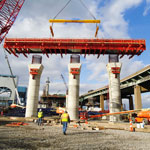At a Glance
Company headquarters
Carpinteria, CA
Construction/facilities employees
83
Average project duration
90-102 days
Current locations
3,285
In the fast-paced fast-food industry, keeping up with shifting consumer trends is a challenge, especially as the average age of consumers continues to shift. Millennials have a whole different idea of what a fast-food chain should look and feel like than their parents and grandparents did. Recognizing this, CKE Restaurants, Inc., owner of the Carl’s Jr. and Hardee’s brands, has been working to make its thousands of national and international properties appealing to the next generation. “CKE is committed to drawing customers in and keeping them coming back, … and good restaurant design is a very big part of that,” says Jack Willingham, CKE’s senior vice president of construction and design.
By the end of 2013, CKE will have completed the remodeling of more than 1,400 restaurants in the United States, closing the books on a six-year project to make the stores more inviting to its customer base. And now, it’s preparing a cleaner, more sustainable design for the future.
“I came on board in 2006 to help [CKE] develop a remodel we could employ throughout the system,” Willingham says. Part of the upgrade included revising the Hardee’s brand, which CKE acquired in 1997, to have the same look, feel, and menu as Carl’s Jr. The remodeling involved the installation of new seating, flooring, and wall finishes, and the exteriors of each location were made to look warmer, brighter, and more inviting through new signage and coloring.
In 2012, CKE began testing a more contemporary design in some of its new stores. A high percentage of fast-food visits are spur-of-the-moment decisions, Willingham says, so the buildings must be as inviting as possible. Inspired by CKE’s international locations, the new look is clean, fresh, and modern. Upholstered booths have replaced fiberglass seats, windows are taller to let in more light, and wall spaces are covered with murals featuring local iconic symbols to make customers feel at home.
“This new generation needs different things than the previous one,” says Willingham, who spends a lot of time studying data on customer behavior. “[For instance], they don’t want to feel enclosed; they want a more open atmosphere. So we try to keep the layout as open as possible. Now there’s lots more glass and light. We also have some community tables because the younger crowd likes to get together. That’s new for us. We’re even looking at putting in iPad stations. We have to be prepared to provide that kind of atmosphere.”

CKE has also made great strides toward more sustainable and energy-efficient restaurants. The company reduced the size of its new stores from 2,960 to 2,500 square feet and limited seating to 54, down from 66–72 seats. The shift allowed Willingham’s team to cut the number of air-conditioning units from three to two. “Sixty-three percent of our customers go through the drive-through today,” Willingham says, “so restaurants don’t need the massive square footage or seating they used to have. All fast-food restaurants are struggling with the rising cost of operations. We have to find that balance between making them look more inviting and operating the restaurant profitably. The first [new store] we did generated $100,000 in sales the first week.”
CKE has experimented with a variety of green features in its new stores, including solar power, water recycling, and recycled tiling. All new equipment is Energy Star-rated, and, years ago, the company was one of the first in the fast-food industry to put LED lighting in parking lots. Window glass is low-E, and solar tubes bring sunlight into storage spaces. “We’re also looking into providing charging stations for electric vehicles,” Willingham says. The company regularly follows LEED requirements and has completed two LEED-certified restaurants—in Irvine and Anaheim, California—in the last two years.
CKE recently conducted a 20-store test of a complete energy-management system. Instead of turning on multiple circuit breakers when they arrive, store managers can just flip a single switch to activate a system that adjusts heat, air, and lighting to preset levels. During the test period, “Carl’s Jr. recognized a seven percent savings in energy while Hardee’s saw a 14 percent savings,” Willingham says. CKE is now expanding the system to 100 stores.
Over the next 12 months, Willingham plans to continue testing and rolling out the new interior design while meeting expansion goals and maintaining a focus on energy efficiency and sustainability. He looks forward to the response. “I love creating something,” he says “and then standing back and watching it perform as intended and seeing the customer’s reaction.” ABQ
_____

Meet Jack Willingham
Where did you go to school?
I have a bachelor of science degree in engineering from the University of Tulsa in Oklahoma.
What was your first construction job?
Growing up in the family construction business [Willingham Construction], I was a journeyman carpenter by the time I graduated high school but always preferred the architectural and management side of the business. After a five-year stint in the US Air Force, I went to work for an architectural firm that had restaurants as clients. It was there I discovered that I really enjoyed the challenges of restaurant design.
How did you wind up working for CKE Restaurants?
I spent 30 years working for both Sambo’s Restaurants and Perkins Restaurants before going out on my own to build, design, and consult with restaurants. In 2006, while consulting for CKE, the firm offered me a job and I accepted.
What personal goals do you have in your current role?
My goal is always to find the perfect balance between good, efficient design and cost so that the business can make a profit. Also, I am constantly trying to understand the customer and design a building that fits their needs.


